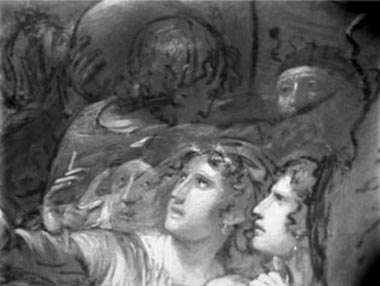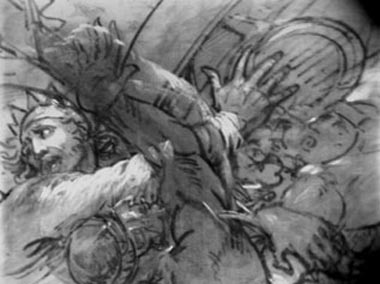 Benjamin West Benjamin West
Pharaoh and His Host Lost in the Red Sea, 1792
and after 1800
Technical Notes
The painting's primary support is a finely woven plain-weave canvas. The vertical tacking edges have been flattened during past lining treatments and show the original tacking holes. The top and bottom tacking edges have been trimmed but still show the original foldover edge. The present size of the painting is larger than the original dimensions. The ground layer is slightly gray and extends over what remains of the tacking edges.
A painted sketch of the composition was first done on the canvas with thin, dark contour lines. After the sketch, thin semitransparent applications of dark brown paint were applied to establish general areas of light and dark. Areas of color and finer details were later applied in a more precise manner, wet-on-dry. The upper half of the painting has a higher degree of completion than the lower half, which has a minimal amount of highlights and color.
Examination with infrared vidicon shows that some minor changes were made to the original brush drawing, such as in the fingers of the angel in the upper right. Two faces are notable for having no underdrawing, unlike the other faces. One is that of the woman at left among the group of three women; the other is that of the old man just above the woman to the right (fig. 1).
|
 |
 |
Figure 1. In this infrared reflectogram detail, the woman at the bottom left and the man at the upper right do not have an underdrawing and therefore appear to have been added when West reworked the painting. |
Infrared vidicon also reveals that West made slight adjustments to his design as he began applying color on top of his monochromatic underpainting. Most noticeably, the extended arm of the falling soldier in the center foreground was moved to the right. The soldier's hand was shifted so that it was no longer bent perpendicular to the arm, with the palm turned slightly toward the viewer, but positioned to continue the arc created by the arm (fig. 2).
Drying cracks are evident within the brown semitransparent glazes. Retouching is visible in the shadows and cape of the figure at the upper left, and toned washes have been applied to areas where the brown glazes were likely overcleaned. Small scattered losses have also been retouched.
Treatment records indicate that the most recent varnish application consists of a spray coat of Acryloid B-72 applied in 1983.
|
 |
 |
Figure 2. Infrared reflectogram detail of West's change in the position of the soldier's arm in the bottom center portion of the painting. |
|